Surface water conditions in California have recovered dramatically in recent months, but some consequences of the 2012-2016 drought likely will linger for years. This Insight discusses the status of the drought and how it affected groundwater supplies: declines in groundwater levels, decreased storage capacity, and land subsidence. In response to the drought, the 114th Congress enacted legislation (P.L. 114-322) that altered the authorities regarding how federal water infrastructure in the state is managed and how new water storage may be developed. (See CRS In Focus IF10626, Reclamation Water Storage Projects: Section 4007 of the Water Infrastructure Improvements for the Nation Act). In the 115th Congress, there is both interest and concern about the federal role and funding for new water infrastructure to cope with the next drought and with hydrologic conditions that can quickly transition from drought to flood conditions.
What a Difference a Year Makes
After five years of drought, California is experiencing wetter-than-normal conditions in 2017. For example, snowpack water content in the Sierra Nevada Mountains as of April 5, 2017, stood at 159% of average.
|
Figure 1. California Snow-Water Content: April 5, 2017
(for the North, Central, and South Sierra Nevada)
|
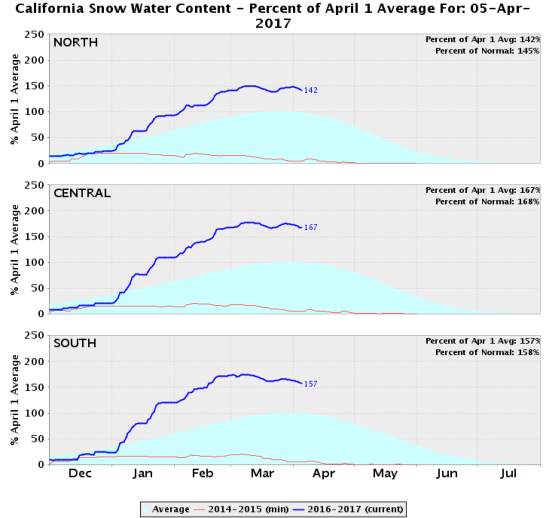 |
|
Source: California Department of Water Resources (CA DWR).
Notes: Light blue shaded area indicates the average value; dark blue line indicates 2016-2017; red line indicates the 2014-2015 year, which was the minimum recorded. All lines indicate the percentage relative to the April 1 average.
|
The U.S. Drought Monitor also indicates that drought conditions statewide have improved markedly compared to recent years.
|
Figure 2. U.S. Drought Monitor Comparison of California: 2016 Versus 2017
(left: April 5, 2016; right: April 4, 2017)
|
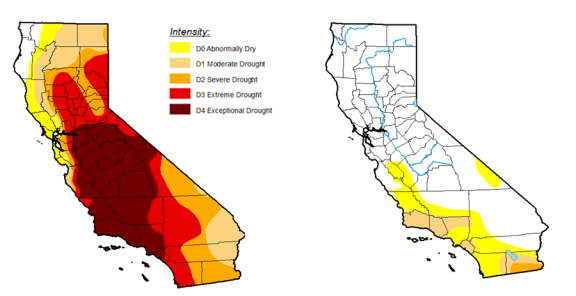 |
|
Source: U.S. Drought Monitor.
|
In early April 2016, approximately 55% of California was classified as experiencing at least extreme drought conditions and nearly 32% was experiencing exceptional drought. A year later, none of the state is classified as experiencing extreme or exceptional drought and more than three-quarters of California is not facing any drought conditions.
Why Is 2017 Different?
A series of winter storms—known as atmospheric rivers, or ARs—tracked across California during the 2016-2017 winter and dropped snow and rain nearly statewide. ARs are also referred to as "drought busters" for their ability to deliver huge amounts of precipitation over a short period of time. Studies indicate that ARs are the source of 30%-50% of all precipitation along the U.S. West Coast. The 2016-2017 winter storms were primarily responsible for statewide precipitation levels in January 2017 of 10.3 inches and in February 2017 of 8 inches, corresponding to 225% and 166%, respectively, above the average for those months since 1895.
ARs can erase one natural hazard, drought, but can cause another hazard—floods. They are the source of a large majority of floods along the U.S. West Coast, according to studies. When ARs deliver above-average winter precipitation, reservoir managers must balance maintaining reservoir storage space to capture floodwaters with keeping reservoirs full (with little flood storage capacity) to meet water supply demands during the summer. Recent conditions at Lake Oroville, California's second-largest reservoir, highlighted that challenge.
Is the Drought Over?
The U.S. Drought Monitor and other indicators (e.g., current status of the state's major reservoirs) suggest that the drought has largely abated for most of California, and Governor Brown recently announced an end to the statewide Drought State of Emergency. However, the cumulative effects of the multiyear drought—particularly on groundwater supplies—are significant. Unlike surface water, which can recover from drought relatively quickly in a wet year, the amount of groundwater stored in many depleted aquifers likely will take much longer to recover and may never regain pre-drought levels.
|
Figure 3. Reservoir Conditions for Major California Reservoirs
|
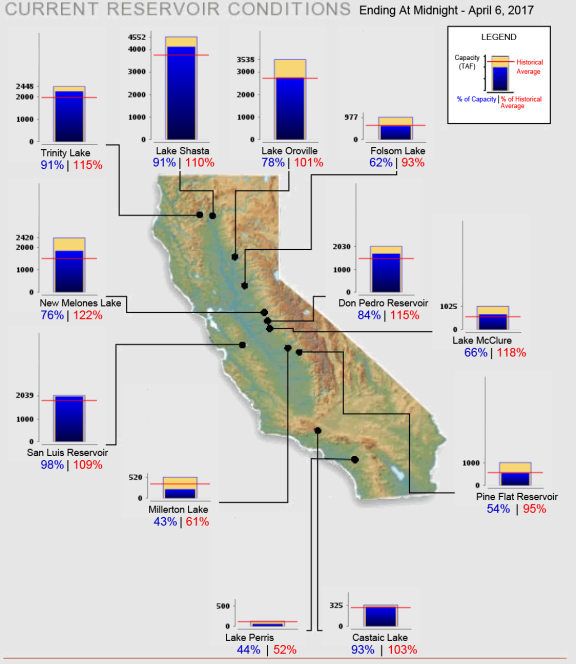 |
|
Source: CA DWR.
|
During the recent drought, California irrigators increasingly relied on groundwater to substitute for surface water. Consequently, groundwater levels in the state's Central Valley dropped, particularly in the San Joaquin Valley (SJV). For example, aquifer levels in parts of the SJV experienced water-level drops of more than 50 feet between 2011 and 2016. In some locations, decreased groundwater levels cause the ground surface to drop in elevation (land subsidence). Subsidence was as much as 22 inches in some areas of the southern SJV between 2015 and 2016.
|
Figure 4. Change in Groundwater Levels in California
(fall 2011 to fall 2016)
|
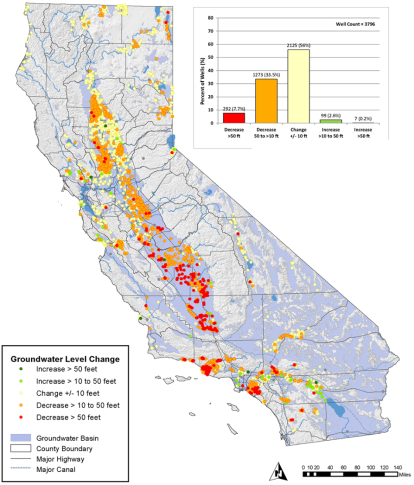 |
|
Source: CA DWR.
Note: Groundwater level changes determined from water level measurements in wells.
|
In some locations the land surface may rebound a small amount (known as elastic deformation) with groundwater recharge; for many locations, the land surface does not recover (inelastic deformation). Parts of the southern SJV experienced nearly 27 feet of permanent land subsidence in the last century due to groundwater pumping. Permanent subsidence means that the thickness of the aquifer shrinks, which decreases the aquifer's capacity to store groundwater. Another potential consequence is damage to surface structures, such as canals, levees, roads, and foundations of structures. The recent drought, for example, resulted in damage to the Delta-Mendota Canal, buckling the concrete sides in some places. In another area of the canal, a bridge dropped so low it nearly touched the surface of the water.
|
Figure 5. How Land Subsidence Occurs When Groundwater Levels Drop
|
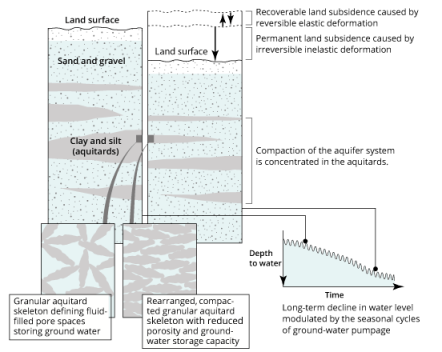 |
|
Source: U.S. Geological Survey, Land Subsidence: Cause & Effect.
Note: An aquitard is a layer or portion of the sediments that restricts water flow between aquifers.
|
Outlook
The atmospheric river "drought-busters" have nearly wiped out the surface water deficit in California that built up during five years of drought, and high snowpack levels portend that reservoirs will be amply supplied during spring runoff. Groundwater storage deficits linger, however, and serve as a reminder that the drought's unseen effects likely will be felt for many years. How groundwater and surface water are stored and managed and how federal initiatives in P.L. 114-322 are carried out, together with state and local actions, likely will shape California's resilience to its next drought.




